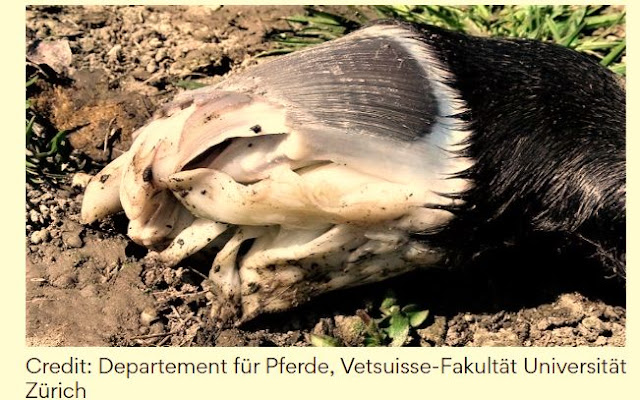Newborn horse hooves:
Curious Appearance of Newborn Horse Hooves: Unraveling the Mystery
Newborn
horses immediately rely on their hooves for swift movement soon after birth.
When a mare delivers a foal, the birthing tissues emitted can attract
predators. In the wild, as prey animals, horses need to be prepared to flee
post-birth. Despite being born with fully formed hooves, their appearance might
seem unconventional initially.
At the
moment of birth, newborn foals possess a supple, velvety layer covering their
hooves, referred to as the eponychium. Derived from Greek, meaning "on top
of" and "little claw," it's also known as the deciduous hoof
capsule. Comprised of the same horn tubules, keratin, and lamellae found in
adult horse hooves, this protective layer safeguards the mare's uterus and birth
canal from potential harm caused by the foal's hooves during the normal
birthing process.
During
late gestation in the womb, foals are incredibly active, much like human
babies, moving and kicking within the uterus. A typical birthing process
entails the front legs of the foal emerging first through the birth canal. The
deciduous hoof capsule serves as a shield, preventing injuries that might be
caused by the foal's hooves to the mare's uterus and birth canal.
Appearance
of Newborn Horse Hooves:
Newborn
foal hooves resemble miniature versions of adult hooves, yet they are enveloped
by the deciduous hoof capsule, resembling rubbery finger-like projections
coated in a viscous material. Some liken this appearance to a grouping of damp
feathers stuck together.
What's
the Duration for Foal Hooves to Firm Up?
Shortly
after birth, the exposure of the deciduous hoof capsule to the air initiates
the drying and hardening process. Once hardened and as the foal starts walking,
this capsule naturally sheds. Typically, the complete shedding of the hoof
capsule occurs within 48 to 72 hours after birth.
A
foal's hoof shape will gradually transform. Initially, it appears tapered,
wider at the top and narrower at the ground contact point. Over time, the
foal's hoof not only lengthens but also broadens. As the foal applies weight to
the hoof, the bottom wall begins to expand, and the weight-bearing surface
becomes the broader part of the hoof.
At what stage do foals require hoof maintenance?
Regular
hoof care is crucial for foals. It's recommended that foals have their initial
assessment by a farrier at 3 to 4 weeks of age. During this evaluation, the
farrier gently rasps the toe to ensure it is squared off.
The
hooves of foals grow at a rate of approximately 0.4 millimeters per day, nearly
twice as fast as those of adult horses. Following the first visit, foals should
be scheduled for monthly appointments with the farrier. The objective is to
encourage the growth of a robust, resilient hoof wall. Additionally, these
monthly visits aid in instilling good behavior and manners in the foal for its
future.
Possible Challenges with Foal Hooves
Issues
during the development of foal hooves often involve their lower legs. Some
common complications include:
Clubfoot
Tendon
contracture or laxity
Angular
limb deformities
To
address these abnormalities, it's crucial to engage your veterinarian and seek
their guidance in managing these medical concerns. Collaborating with both your
veterinarian and farrier for early intervention and strategic management of developmental
issues is vital to ensure the foal grows into a healthy, mature adult.
Conclusion:
In
summary, understanding the intricacies of foal hoof development is essential
for proper care and management. From the peculiar appearance of newborn hooves
to the subsequent hardening and shedding of the deciduous hoof capsule, each
stage plays a vital role in a foal's early life. Initiating routine farrier
care and veterinary attention at the appropriate intervals ensures the healthy
growth and development of the hooves, significantly impacting the foal's future
well-being. Vigilance in addressing potential complications is key, and early
intervention, guided by both veterinarians and farriers, serves as the
cornerstone for ensuring a foal's journey towards becoming a sound and robust
adult horse.



Post a Comment
Please do not enter any spam link in the comment box.
Regards